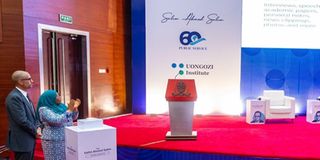Prime
Declassified notes shed new light on Africa’s global diplomacy role

President Samia Suluhu Hassan claps during the launch of the Salim Salim Dig Archive. PHOTO | FILE
What you need to know:
- Alongside the Cuba files, the archive has released additional declassified material from the late 1990s, shedding light on diplomatic efforts surrounding the Ethiopia–Eritrea conflict.
Dar es Salaam. Newly declassified documents from the Salim Ahmed Salim (SAS) Digital Archive have revealed fresh perspectives on Africa’s diplomatic engagement at the United Nations and beyond, offering rare insights into high-level manoeuvres and candid exchanges during key moments in recent history.
Among the most striking releases is a confidential record dated August 5, 1980, capturing a late-night meeting in Havana between Dr Salim Ahmed Salim — who was then President of the UN General Assembly — and Cuba’s Vice Minister for Foreign Affairs, Mr Ricardo Alarcón.
The discussion, held during Dr Salim’s official visit to Cuba, reflects Havana’s strong support for his potential candidacy for the role of UN Secretary-General.
Against the backdrop of Cold War rivalries and growing demands for a stronger Third World presence in global leadership, the Cubans emphasised the strategic importance of his candidacy.
In a remarkable show of solidarity, Cuba’s then Foreign minister later inscribed his support for Dr Salim on the wall of Havana’s iconic Bodeguita del Medio restaurant, a symbolic gesture in a venue renowned for hosting international luminaries.
Alongside the Cuba files, the archive has released additional declassified material from the late 1990s, shedding light on diplomatic efforts surrounding the Ethiopia–Eritrea conflict.
One of the highlights is a candid conversation between Dr Salim and the late Mwalimu Julius Nyerere, former President of the United Republic of Tanzania, in which the two leaders discussed the shifting regional dynamics, the challenges of maintaining Third World solidarity, and the realities of global power politics.
The documents also trace the role of Iraq, Cuba, and other allies in rallying behind Dr Salim’s UN bid, revealing the strategic calculus that underpinned their support.
Further insights include sensitive exchanges between Dr Salim and former United States National Security Advisor, Mr Anthony Lake, focused on salvaging peace efforts in the Horn of Africa.
The records detail the diplomatic tightrope walked by African leaders, working through Italy and the Organisation of African Unity (OAU), as they navigated competing interests and attempted to broker peace amid escalating tensions in the region.
The SAS Digital Archive continues to offer an invaluable lens into Tanzania’s diplomatic footprint and Africa’s broader contribution to international affairs.
Through the legacy of Dr Salim, the archive highlights the continent’s evolving political and strategic role on the global stage, while deepening public understanding of the critical, and often understated, work that shaped regional and international diplomacy.





